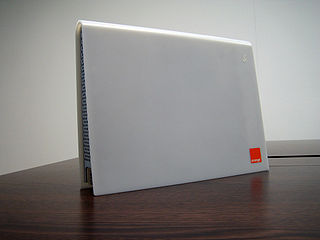
AirPort is a discontinued line of wireless routers and network cards developed by Apple Inc. using Wi-Fi protocols. In Japan, the line of products was marketed under the brand AirMac due to previous registration by I-O Data.

Wi-Fi is a family of wireless network protocols based on the IEEE 802.11 family of standards, which are commonly used for local area networking of devices and Internet access, allowing nearby digital devices to exchange data by radio waves. These are the most widely used computer networks, used globally in home and small office networks to link devices and to provide Internet access with wireless routers and wireless access points in public places such as coffee shops, restaurants, hotels, libraries, and airports.
A wireless gateway routes packets from a wireless LAN to another network, wired or wireless WAN. It may be implemented as software or hardware or a combination of both. Wireless gateways combine the functions of a wireless access point, a router, and often provide firewall functions as well. They provide network address translation (NAT) functionality, so multiple users can use the internet with a single public IP. It also acts like a dynamic host configuration protocol (DHCP) to assign IPs automatically to devices connected to the network.
The Freebox is an ADSL-VDSL-FTTH modem and a set-top box that the French Internet service provider named Free provides to its DSL-FTTH subscribers.

The Linksys WRT54G Wi-Fi series is a series of Wi-Fi–capable residential gateways marketed by Linksys, a subsidiary of Cisco, from 2003 until acquired by Belkin in 2013. A residential gateway connects a local area network to a wide area network.
Netgear, Inc., is an American computer networking company based in San Jose, California, with offices in about 22 other countries. It produces networking hardware for consumers, businesses, and service providers. The company operates in three business segments: retail, commercial, and as a service provider.

A wireless router or Wi-Fi router is a device that performs the functions of a router and also includes the functions of a wireless access point. It is used to provide access to the Internet or a private computer network. Depending on the manufacturer and model, it can function in a wired local area network, in a wireless-only LAN, or in a mixed wired and wireless network.
Qualcomm Atheros is a developer of semiconductor chips for network communications, particularly wireless chipsets. The company was founded under the name T-Span Systems in 1998 by experts in signal processing and VLSI design from Stanford University, the University of California, Berkeley, and private industry. The company was renamed Atheros Communications in 2000 and it completed an initial public offering in February 2004, trading on the NASDAQ under the symbol ATHR.

SpeedTouch is a line of customer-premises equipment that was initially produced by Alcatel and later by Thomson Multimedia. It includes ADSL and ADSL2+ modems, residential gateways, wireless access equipment, VoIP handsets and SHDSL interconnect equipment. They are a major brand in home and business networking products.
The DSL-G604T is a first D-Link Wireless/ADSL router which firmware is based on open source the MontaVista Linux. The DSL-G604T was introduced in November 2004. This model has been discontinued.

Orange Livebox is an ADSL wireless router available to customers of Orange's Broadband services in Kenya, Guinea, France, Tunisia, Spain, Jordan, the Netherlands, Switzerland, Poland, Belgium, The United Kingdom (Formerly), Mauritian partner MyT, Lightspeed Communications in Bahrain and Orange Botswana. Depending on the model, it is manufactured by Inventel, Sagecom or ZTE. The Livebox is also known as FunBox in some countries like Poland, Ivory Coast and Senegal.

The BT Smart Hub is a family of wireless residential gateway router modems distributed by BT for use with their own products and services and those of wholesale resellers but not with other Internet services. Since v 5, Home/Smart Hubs support the faster Wi-Fi 802.11ac standard, in addition to the 802.11b/g/n standards. All models of the Home Hub prior to Home Hub 3 support VoIP Internet telephony via BT's Broadband Talk service, and are compatible with DECT telephone handsets. Since the Home Hub 4, all models have been dual band.
Operating system Wi-Fi support is defined as the facilities an operating system may include for Wi-Fi networking. It usually consists of two pieces of software: device drivers, and applications for configuration and management.

Buffalo AirStation is the name given to a series of wireless LAN equipment sold by Buffalo Technology.

The Texas Instruments AR7 or TI-AR7 is a fully integrated single-chip ADSL CPE access router solution. The AR7 combines a MIPS32 processor, a DSP-based digital transceiver, and an ADSL analog front end.
The WGR614L is an 802.11b/g wireless network router created by Netgear. It was officially launched on June 30, 2008. The WGR614L runs an open source linux firmware and supports the installation of third party packages such as DD-WRT, Tomato, and OpenWrt.
Linksys manufactures a series of network routers. Many models are shipped with Linux-based firmware and can run third-party firmware. The first model to support third-party firmware was the very popular Linksys WRT54G series.

The O2 Wireless Box is a wireless residential gateway router distributed by O2. The latest version is based on the 802.11n standard and also supports 802.11g and 802.11b devices. The device connects to the Internet using either an ADSL2+ or ADSL connection.

The WNR3500L is an 802.11b/g/n Wi-Fi router created by Netgear. It was officially launched in the autumn of 2009. The WNR3500L runs open-source Linux firmware and supports the installation of third party packages such as DD-WRT and Tomato.















